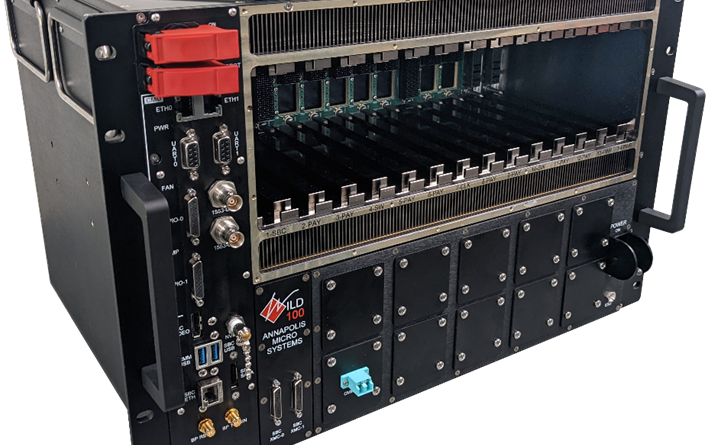New High-Density 3U VPX Switches and Chassis Support Dual 100Gb Ethernet, 8x Gen4 PCIe, or 16 LVDS
Annapolis Micro Systems has an HD Switch and Chassis in final design verification, with customer shipping scheduled for December. They are the industry’s first COTS products to integrate high-density VITA 91 connectors that double the available backplane density.
The WILDSTAR 3U OpenVPX Switch (WP3E20) offers up to 128 different pairs of Ethernet. The WILD100 13-Slot 3U OpenVPX Chassis (WC31DH) offers up to 64 lanes of Ethernet or PCIe or 128 LVDS pairs.
The rugged WP3E20 Switch is the next-gen version of Annapolis’ best-selling SOSA™-aligned WP3E10 Switch. Both provide switching between backplane slots of multiple channels of 100Gb Ethernet, front panel I/O, separate data, and control plane switches, and two Zynq UltraScale+ processors that support encrypted secure communication.
The WP3E20 also has HD connectors, which deliver dramatic bandwidth increases and latency reductions. It features up to fourteen 40/100Gb and twenty-four 1/10/25Gb or six 40/100Gb Ethernet ports. This enables deployment for low-latency jamming or radar applications.
“The new VITA 91 high-density connector allows for a completely switched backplane, so the expansion plane is no longer defined by a fixed backplane PCB but is now fully reconfigurable,” said Jay Grandin, Annapolis Micro Systems VP of Product Development.
“This not only allows for all the slots to be on the same non-blocking Ethernet switch instead of two switches chained together, but it facilitates a flexible, programmable expansion plane. The expansion plane supports either 8x Gen4 PCIe, 4x Gen4 PCIe plus eight LVDS, or 16 LVDS to each payload slot using the WP3P20 Switch, which is software-configurable on a per-slot basis. With the double-density WP3E20 100GbE switch, two existing standard VPX switch slots can be combined into a single high-density switch slot, freeing up a slot for the WP3P20 Expansion Plane Switch.”
The chassis includes a secure WILD Chassis Manager (WABGM2). It is SOSA-aligned, VITA 46.11 compliant, and powered by a Xilinx UltraScale+ ZU11EG MPSoC and Microsemi PolarFire MPF200T FPGA for security functions. Multiple security and advanced features are available.

